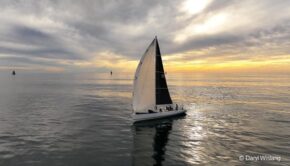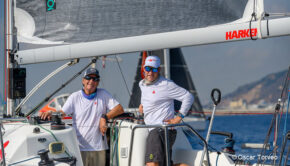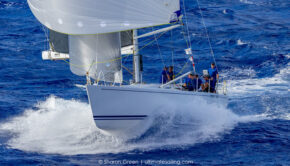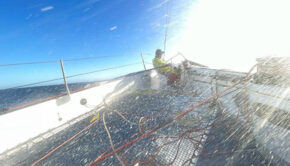The big secret about weather apps
Published on May 28th, 2020
Peter Isler, a world renowned sailor, educator, and two-time America’s Cup winning navigator, has a secret he wants to share. We’ll let him explain…
When was the last time a friend bragged about their latest “weather app du jour” that is the “best ever” for forecasting the wind in a particular location? It happens to me a lot. And most of the time, when I check out the app or website – it’s just a new-fangled “repackaging” of a weather model that is freely available (often thanks to some nation’s taxpayer funding) in a host of places.
Now, weather models are good things – invaluable tools for meteorologists, but they are not created equally – and none of them are always or exactly right.
In the right hands, these models (the grist for the forecasting output of 99.9% of every weather app out there) can provide invaluable data that will result in good forecasts. But used blindly in their raw form (e.g. with the thumb swipe to the screen) – well, let’s say their batting average won’t get you into the Hall of Fame.
It’s kind of like self-medicating with hydroxychloroquine to prevent a coronavirus infection…. you might do okay but you would probably be better off if you enlisted a medical doctor to direct your treatment.
I studied meteorology in college, obtained a bachelor’s degree in that fine course of study, and I have raced sailboats professionally for most of my life. I have navigated boats to offshore course records in both hemispheres, and on both the Pacific and the Atlantic. So you’d probably agree that my weather savvy is above the median. And yes, I use weather apps (want to know my favorites? – hang on for a minute – the answer isn’t as simple as you may hope).
I use weather models regularly, but when there’s big money on the line, I do more than “swipe up” on my favorite app. I use these weather tools from an ‘informed’ position that just might some day get me into the tacticians’ hall of fame.
I appreciate important characteristics of different models – like their pedigree, resolution, initialization time and more – and that helps me be more discerning when looking at their output and ultimately assists me in making better decisions in my forecasting/tactics.
Don’t get me wrong – I love weather apps…. and use them all the time.
For example, when it comes to deciding whether I can get one or two more good runs in on my windsurfer before a thunderstorm (still learning to kite – so probably wouldn’t cut it so close), there’s nothing like the amazing weather radar we have here in the US – available (repackaged) on just about every good weather app. And before a long backcountry horse ride when there’s rain threatening, I have my go-to apps.
But here’s fact of life #42 – Weather forecasts have their limitations. They have been the brunt of jokes about their inaccuracies for centuries and now that computers have gotten into the game – they too have had their share of spectacular failures. That’s when we come back to the batting average analogy.
When I’m really serious about getting the weather right, I work hard at it – burning the midnight oil – not relying on a single data source, app, or model. And I don’t just look on my phone/computer. I do what sailors have been doing for centuries – looking at the sky, the present conditions, and I scan the horizon for clues. Because it is the human side of the forecast process that the app-bound sailor misses out on – it is a big swing and a miss.
And when I’m really serious about getting the weather right – I hire a professional. You see, even if I’m better than most professional meteorologists at running weather routing software – they are probably better than me at the human side of the art and science of weather forecasting… the part where you have to decide between all the different forecast outputs (by definition every one of them is always ‘wrong’ to a degree – never perfect.)
Weather professionals do it for a living and some are really good at what they do. They don’t have to get a good night sleep before the race, they don’t have to attend the skippers meeting, or work on some last minute item on the boat’s to-do list, and they probably have a good internet connection to be able to send out a crew email/whatsapp when I’m still packing my sea bag.
For me, having an outside meteorologist providing a morning forecast before a big race is money well spent and allows me to better do my job.
All this brings me to a new endeavor – Marine Weather University. I’ve teamed up with my weather guru and long-time friend, Chris Bedford (sailwx.com) to create an online school to teach sailors about the weather. Chris is adroit at teaching the weather – he’s one of those people who have the ability to make complex subjects become understandable.
Marine Weather University is designed to help sailors go beyond their favorite weather app and build a foundation of knowledge that will make them smarter about the weather. Chris has designed the curriculum with that goal in mind. Classes are rolling out throughout the summer with the first launching in a live webinar on June 2.
Ultimately all classes will be online for 24/7 access. Students can sign up for single classes, but we encourage they take one of MWU’s two full courses (Fundamentals or Advanced) – where the classes are bundled together, in a curriculum designed by Chris– like a real university course.
Check it out – you will learn what are my favorite apps (and Chris’ too), but more importantly, you’ll learn about the weather the right way. You will be able to read the sky better, make the most of the data you have available, and understand the limitations and strengths of your weather information.
Details: http://marineweatheru.com/
Editor’s note: Scuttlebutt is offering a promo code for 10% discount through June 2. Use: SBUTTFAM









 We’ll keep your information safe.
We’ll keep your information safe.